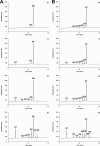4,6-α-glucanotransferase, a novel enzyme that structurally and functionally provides an evolutionary link between glycoside hydrolase enzyme families 13 and 70
- PMID: 21948833
- PMCID: PMC3209003
- DOI: 10.1128/AEM.05735-11
4,6-α-glucanotransferase, a novel enzyme that structurally and functionally provides an evolutionary link between glycoside hydrolase enzyme families 13 and 70
Abstract
Lactobacillus reuteri 121 uses the glucosyltransferase A (GTFA) enzyme to convert sucrose into large amounts of the α-D-glucan reuteran, an exopolysaccharide. Upstream of gtfA lies another putative glucansucrase gene, designated gtfB. Previously, we have shown that the purified recombinant GTFB protein/enzyme is inactive with sucrose. Various homologs of gtfB are present in other Lactobacillus strains, including the L. reuteri type strain, DSM 20016, the genome sequence of which is available. Here we report that GTFB is a novel α-glucanotransferase enzyme with disproportionating (cleaving α1→4 and synthesizing α1→6 and α1→4 glycosidic linkages) and α1→6 polymerizing types of activity on maltotetraose and larger maltooligosaccharide substrates (in short, it is a 4,6-α-glucanotransferase). Characterization of the types of compounds synthesized from maltoheptaose by matrix-assisted laser desorption ionization-time of flight mass spectrometry (MALDI-TOF MS), methylation analysis, and 1-dimensional ¹H nuclear magnetic resonance (NMR) spectroscopy revealed that only linear products were made and that with increasing degrees of polymerization (DP), more α1→6 glycosidic linkages were introduced into the final products, ranging from 18% in the incubation mixture to 33% in an enriched fraction. In view of its primary structure, GTFB clearly is a member of the glycoside hydrolase 70 (GH70) family, comprising enzymes with a permuted (β/α)₈ barrel that use sucrose to synthesize α-D-glucan polymers. The GTFB enzyme reaction and product specificities, however, are novel for the GH70 family, resembling those of the GH13 α-amylase type of enzymes in using maltooligosaccharides as substrates but differing in introducing a series of α1→6 glycosidic linkages into linear oligosaccharide products. We conclude that GTFB represents a novel evolutionary intermediate between the GH13 and GH70 enzyme families, and we speculate about its origin.
Figures






References
-
- Argüello-Morales M. A., et al. 2000. Sequence analysis of the gene encoding alternansucrase, a sucrose glucosyltransferase from Leuconostoc mesenteroides NRRL B-1355. FEMS Microbiol. Lett. 182:81–85 - PubMed
-
- Ausubel F. M., et al. 1987. Current protocols in molecular biology. John Wiley & Sons, Inc., New York, NY
-
- Barends T. R. M., et al. 2007. Three-way stabilization of the covalent intermediate in amylomaltase, an α-amylase-like transglycosylase. J. Biol. Chem. 282:17242–17249 - PubMed
MeSH terms
Substances
LinkOut - more resources
Full Text Sources
Other Literature Sources
Molecular Biology Databases

